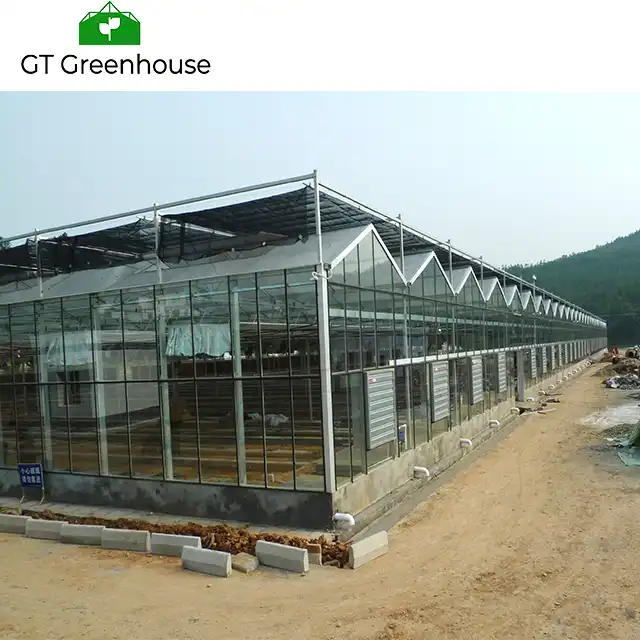Commercial greenhouses have emerged as vital components of modern agriculture, revolutionizing the way crops are grown and meeting the demands of a rapidly changing world. These advanced structures provide controlled environments that optimize plant growth, enhance productivity, and ensure year-round cultivation. In this article, we will explore the concept of commercial greenhouses, their key features, and the benefits they offer to growers and the agricultural industry as a whole. By understanding the potential of commercial greenhouses, farmers and entrepreneurs can harness their advantages to achieve sustainable and profitable cultivation operations.
Purpose and Design
- Definition and Scale:Commercial greenhouses refer to large-scale structures designed for extensive crop production. These facilities are purpose-built to accommodate significant cultivation areas, allowing for efficient commercial farming operations. They are typically used by professional growers, nursery operators, and agricultural businesses.
- Structural Design:Commercial greenhouses feature robust construction and advanced engineering. They often utilize metal frames or sturdy materials to ensure durability and withstand environmental stresses. The structure incorporates various components such as ventilation systems, heating and cooling mechanisms, irrigation systems, and advanced control systems to maintain optimal growing conditions.
Advantages and Benefits
- Extended Growing Seasons:Commercial greenhouses enable growers to extend their growing seasons and cultivate crops year-round. By creating a controlled environment, these structures protect plants from adverse weather conditions, enabling production even during off-seasons or in regions with challenging climates. This allows consistent and reliable harvests, enhancing market competitiveness.
- Enhanced Crop Quality and Productivity:The controlled environment within commercial greenhouses facilitates precise management of factors like temperature, humidity, light, and CO2 levels. This optimization ensures ideal growing conditions, resulting in higher crop quality, increased yields, and improved consistency. Growers can also implement advanced cultivation techniques, such as hydroponics or vertical farming, to further enhance productivity and resource efficiency.
- Pest and Disease Control:Commercial greenhouses provide an effective physical barrier against pests and diseases, minimizing the need for chemical interventions. The enclosed structure helps prevent infestations by insects, birds, and larger animals, reducing crop losses and enhancing overall plant health. Integrated pest management (IPM) strategies can be implemented more easily in commercial greenhouses, promoting sustainable and environmentally friendly practices.
- Efficient Resource Utilization:Commercial greenhouses allow for efficient utilization of resources such as water, energy, and fertilizers. Advanced irrigation systems, such as drip irrigation or hydroponics, minimize water consumption while delivering precise amounts of moisture to plants. Additionally, energy-efficient technologies, such as LED lighting and climate control systems, optimize energy usage, reducing operational costs and environmental impact.
- Economic Viability and Market Opportunities
Increased Profitability:Commercial greenhouses offer significant opportunities for increased profitability. The controlled environment and extended growing seasons allow for multiple harvests per year, maximizing revenue potential. Moreover, the ability to cultivate high-value crops, specialty varieties, or niche products can generate premium prices and capture market demand. - Market Expansion and Supply Chain Control:Commercial greenhouses provide growers with greater control over the supply chain. By producing crops locally and year-round, growers can respond to market demands more effectively, reduce reliance on imports, and offer fresher produce to consumers. This ability to control the supply chain enhances market competitiveness and strengthens relationships with retailers, wholesalers, and local markets.
- Job Creation and Economic Growth:The establishment of commercial greenhouses stimulates job creation and contributes to local economic growth. These facilities require skilled labor for construction, operation, maintenance, and crop management. Moreover, the increased crop production and market opportunities generated by commercial greenhouses can spur additional employment in related industries such as packaging, transportation, and marketing.
Commercial greenhouses represent a transformative force in modern agriculture, offering numerous advantages and opportunities for growers and the agricultural industry. These large-scale structures enable extended growing seasons, enhance crop quality and productivity, provide effective pest and disease control, and optimize resource utilization. By leveraging the benefits of commercial greenhouses, farmers and entrepreneurs can achieve sustainable and profitable cultivation operations, respond to market demands, and contribute to local economies. As the global population continues to grow and agricultural challenges intensify, commercial greenhouses play a crucial role in ensuring food security, promoting efficiency, and driving innovation in the agricultural sector.

